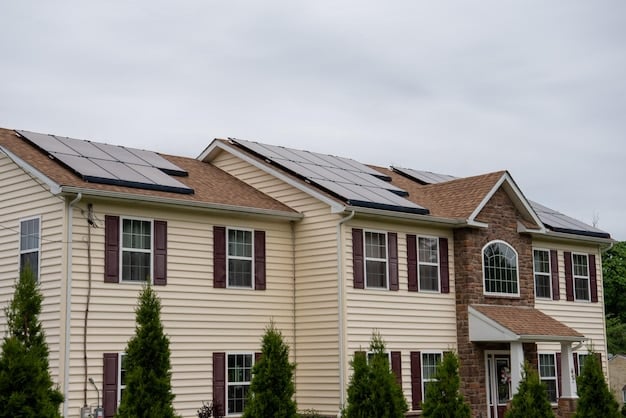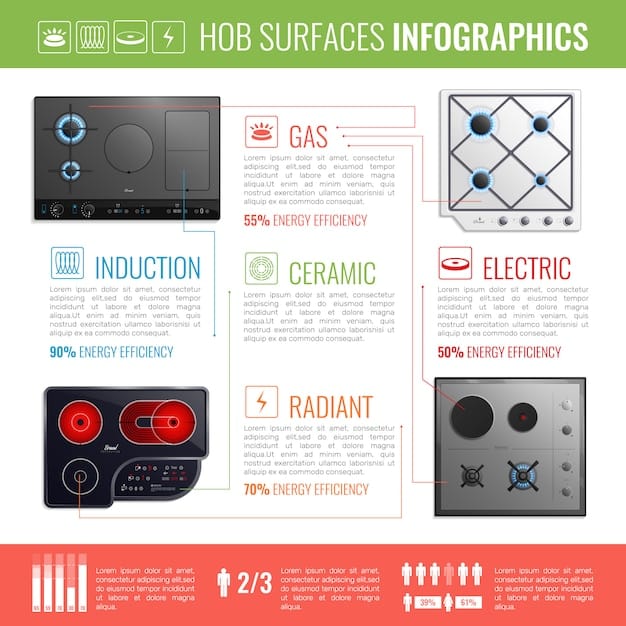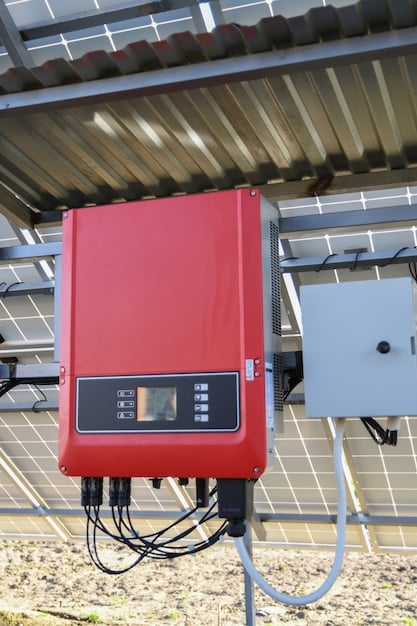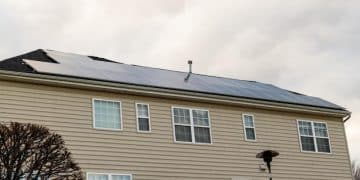Ready for Battery Backup? A 5-Step Checklist for US Homes

Is Your US Home Ready for a Battery Backup? A 5-Step Checklist for Optimal Energy Storage Integration helps homeowners evaluate their home’s suitability for battery backup, ensuring seamless integration and maximum energy resilience during outages.
Are you considering adding a battery backup system to your US home? Ensuring your home is ready for this upgrade is crucial for optimal performance and safety. This guide, Is Your US Home Ready for a Battery Backup? A 5-Step Checklist for Optimal Energy Storage Integration, provides a straightforward checklist to help you determine your home’s readiness and prepare for a seamless installation.
Assessing Your Energy Needs
Before diving into the technical aspects, it’s essential to understand your household’s energy consumption patterns. This knowledge will help you select the right battery size and ensure it meets your needs during power outages.
Calculate Your Daily Energy Usage
Start by reviewing your electricity bills for the past year. This will give you a general idea of your average monthly energy consumption. Then, break down your daily usage.
- Identify essential appliances: Determine which appliances are critical during a power outage, such as refrigerators, medical devices, and lighting.
- Estimate wattage: Check the wattage of each essential appliance. This information is usually found on the appliance itself or in its user manual.
- Calculate run time: Estimate how many hours per day each appliance needs to run during an outage.

By multiplying the wattage by the run time for each appliance, you can estimate your total daily energy needs. This will help you determine the necessary battery capacity to keep your essential appliances running during an outage.
Consider Future Expansion
Think about any future changes that might increase your energy consumption, such as adding electric vehicles, expanding your home, or installing new appliances. Factoring these potential changes into your calculations ensures your battery backup system will meet your needs for years to come.
Understanding your energy needs is the first step toward ensuring your home is prepared for a battery backup system. Accurate assessment and future planning will lead to a more effective and reliable energy storage solution.
Evaluating Your Electrical System’s Capacity
A critical step in preparing for a battery backup system is evaluating your home’s electrical system. This involves checking the main electrical panel, wiring, and grounding to ensure they can handle the new system.
Inspect Your Main Electrical Panel
The main electrical panel is the central hub of your home’s electrical system. It’s crucial to ensure it has sufficient capacity to accommodate the battery backup system.
- Check amperage: Determine the amperage rating of your main electrical panel. This is usually indicated on the main breaker.
- Assess available space: Verify if there are available slots for new breakers to connect the battery backup system.
- Consider upgrading: If your panel is old or lacks capacity, consider upgrading it to a higher amperage to support the new system.
An undersized or outdated electrical panel can lead to overloading, tripping breakers, and even electrical fires. Upgrading your panel ensures the safe and efficient operation of your battery backup system.
Wiring and Grounding
Proper wiring and grounding are essential for the safe and reliable operation of any electrical system, including battery backups.
Ensure that the wiring in your home is in good condition and meets current electrical codes. Look for any signs of damage, such as frayed wires or loose connections. Proper grounding is equally important to protect against electrical shocks and surges.
Evaluating your electrical system’s capacity is a vital step. It guarantees that your home can safely and efficiently support a battery backup system, preventing potential issues down the road.
Assessing Solar Panel Compatibility
If you already have solar panels installed, integrating a battery backup system can enhance your energy independence. However, it’s crucial to ensure compatibility between your solar panels and the battery system.
Inverter Compatibility
The inverter plays a key role in converting solar energy into usable electricity. Compatibility between your solar inverter and the battery backup system is essential for seamless integration.
- Check inverter type: Determine the type of inverter you have (string inverter, microinverters, or power optimizers).
- Verify compatibility: Consult with a solar installer or the battery system manufacturer to ensure compatibility with your existing inverter.
- Consider a hybrid inverter: If your current inverter is not compatible, consider upgrading to a hybrid inverter that integrates solar and battery storage functions.

Inverter compatibility ensures that your solar panels and battery backup system work together efficiently, maximizing energy production and storage.
Battery Charging Capabilities
Ensure that your solar panels can adequately charge the battery. The battery’s charging requirements must align with the output of your solar panels to ensure efficient energy storage.
Consult with a professional to assess the charging capabilities of your solar panels and determine if additional panels are needed to fully charge the battery. This ensures that your battery is always ready to provide backup power when needed.
Assessing solar panel compatibility is essential for homeowners seeking energy independence through solar and battery storage. Proper integration maximizes efficiency and reliability.
Obtaining Necessary Permits and Approvals
Installing a battery backup system often requires obtaining permits and approvals from your local government. These regulations ensure that the installation meets safety standards and complies with local building codes.
Research Local Regulations
Start by researching the specific regulations in your area. Contact your local building department or visit their website to find information on permits and inspections required for battery backup installations.
Understanding local regulations helps you navigate the permitting process smoothly and avoid potential fines or delays.
Work with Qualified Professionals
Hiring qualified professionals, such as licensed electricians and solar installers, can simplify the permitting process. They are familiar with local codes and can assist you in preparing the necessary documentation.
Working with experienced professionals ensures that your battery backup system is installed safely and in compliance with all applicable regulations.
Obtaining the necessary permits and approvals is a critical step. Compliance ensures a safe and legal battery backup installation, protecting your home and family.
Creating a Backup Power Plan
Having a battery backup system is valuable, but it’s equally important to have a comprehensive backup power plan in place. This plan outlines how you will use the battery power during an outage and ensures efficient energy management.
Prioritize Essential Loads
Identify the most critical appliances and devices that need to be powered during an outage. Prioritize these essential loads to maximize the battery’s runtime.
- Create a list: Make a list of essential appliances, such as refrigerators, medical equipment, and lighting.
- Disconnect non-essentials: During an outage, disconnect non-essential appliances to conserve battery power.
- Use energy-efficient devices: Replace older appliances with energy-efficient models to reduce energy consumption.
Prioritizing essential loads ensures that your battery provides power to what matters most during an outage.
Develop a Communication Strategy
Establish a communication strategy to stay informed during an outage. This includes having a backup communication device and knowing how to contact emergency services if needed.
A well-developed communication strategy ensures that you can stay connected and informed during an outage, enhancing your safety and peace of mind.
| Key Aspect | Brief Description |
|---|---|
| 💡 Energy Needs | Evaluate your essential appliances’ energy consumption to choose an adequate battery size. |
| ⚡ Electrical System | Ensure your electrical panel and wiring can handle the additional load safely. |
| ☀️ Solar Compatibility | Verify your solar panels and inverter work seamlessly with the battery system. |
| 📜 Compliance | Obtain the necessary permits and approvals from local authorities. |
Frequently Asked Questions (FAQ)
▼
The appropriate battery size depends on your energy consumption and the appliances you need to power during an outage. Calculate your essential appliances’ wattage and runtime to determine the required capacity.
▼
The duration a battery backup system lasts depends on the battery size and the load it’s supporting. Properly sized batteries can power essential appliances for several hours or even days.
▼
It’s recommended to hire a qualified professional for battery backup installation due to the complexities of electrical systems and safety requirements. A professional ensures correct and safe installation.
▼
The cost of a battery backup system can vary widely depending on the battery size, brand, and installation costs. Research different options and get quotes from multiple installers to compare prices.
▼
Yes, there may be federal, state, and local incentives available for battery backup systems, including tax credits and rebates. Check with your local government and utility company for available programs.
Conclusion
Preparing your US home for a battery backup system involves careful assessment and planning. By following this 5-step checklist, you can ensure a seamless integration, maximize energy resilience, and enjoy peace of mind during power outages.





